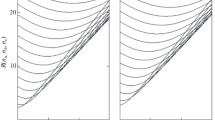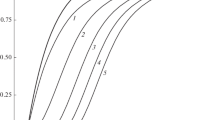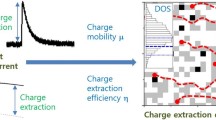Abstract
A kinetic model Nd(Na) of the photovoltaic effect in phthalocyanine (Pc) layers doped with a donor D (acceptor A) in concentration forming one impurity level with energy ED (EA) in the band gap is proposed. The photovoltaic effect is due to the transfer of energy of molecular excitons S1 to neutral A(D) and ionized A−(D+) impurities followed by the formation of electrons and holes: S1 + D(A) → D+(A−) + e−(h+) and S1 + D+(A−) → D(A) + h+(e−). The quasi-stationary concentrations of charge carriers, the population of ionized impurity levels, and the energies of quasi-Fermi levels have been found as functions of light intensity and Ed, Nd (Ea, Na). The values of rate constants that ensure the maximum quantum yield of conversion are discussed.



Similar content being viewed by others
REFERENCES
Benderskii, V.A. and Kim, I.P., High Energy Chem., 2020, vol. 54, no. 6, p. 423.
Benderskii, V.A. and Kim, I.P., High Energy Chem., 2020, vol. 54, no. 6, p. 433.
Bube, R.H., Photoconductivity of Solids, New York: Wiley, 1960.
Yang, S., Fundamentals of Semiconductor Devices, New York: McGraw Hill, 1978.
Sze, S.M. and Ng, K.K., Physics of Semiconductor Devices, New York: Wiley, 2006.
Neamen, D.A., Semiconductor Physics and Devices: Basic Principles, 4th ed., New York: McGraw Hill, 2012.
Usov, N.N. and Benderskii, V.A., Phys. Status Solidi B, 1970, vol. 37, p. 535.
Usov, N.N. and Benderskii, V.A., Sov. Phys. Semoconduct. Phys., 1970, vol. 4, p. 265.
Benderskii, V.A., Belkind, A.I., Fedorov, M.I., and Aleksandrov, S.B., Sov. Phys. Solid State, 1972, vol. 14, p. 573.
Fedorov, M.I. and Benderskii, V.A., Sov. Phys. Semoconduct. Phys., 1970, vol. 4, p. 1071.
Gao, W. and Kahn, A., Org. Electron., 2002, vol. 3, p. 53.
Hill, I.G., Schwartz, J., and Kahn, A., Org. Electron., 2000, vol. 1, p. 5.
Hill, I.G. and Kahn, A., J. Appl. Phys., 1999, vol. 86, p. 2116.
Tang, C.W., Appl. Phys. Lett., 1986, vol. 48, p. 183.
Chan, M.Y., Lai, S.L., Fung, M.K., Lee, C.S., and Lee, S.T., Appl. Phys. Lett., 2007, vol. 90, no. 023504.
Tsuzuki, T., Shirota, Y., Rostalski, J., and Meissner, D., Sol. Energy Mater. Sol. Cells, 2000, vol. 61, p. 1.
Sista, S., Yao, Y., Yang, Y., Tang, M.L., and Bao, Z., Appl. Phys. Lett., 2007, vol. 91, no. 223508.
Yu, G., Gao, J., Hummelen, J.C., Wudl, F., and Heeger, A.J., Science, 1995, vol. 270, p. 1789.
Granström, M., Petritsch, K., Arias, A.C., Lux, A., Andersson, M.R., and Friend, R.H., Nature, 1998, vol. 395, p. 257.
Yakimov, A. and Forrest, S.R., Appl. Phys. Lett., 2002, vol. 80, p. 1667.
Chen, H.-Y., Hou, J., Zhang, S., Liang, Y., Yang, G., Yang, Y., Yu, L., Wu, Y., and Li, G., Nat. Photon., 2009, vol. 3, p. 649.
Drechsel, J., Manning, B., Kozlovski, F., Pfeiffer, M., Leo, K., and Hoppe, H., Appl. Phys. Lett., 2005, vol. 86, no. 244102.
Rucker, Z.F., Waas, D., Buchner, B., Knupfer, M., Zahn, D.R.T., Haidu, F., Hahn, T., Kortus, J., and Belstein, J., Nanotechnology, 2017, vol. 8, p. 1601.
Me, X., Chen, H.-Z., Wang, Y., Shi, M.-M., and Wang, M., J. Phys. Chem. B, 2005, vol. 109, p. 7659.
Walter, M.G., Rudine, A.B., and Wamser, C.C., J. Pophyrins Phthalocyanines, 2010, vol. 14, p. 759.
Hipps, R.W. and Mazur, U., J. Pophyrins Phthalocyanines, 2012, vol. 16, p. 273.
Xu, Z., Zhang, M., Liu, S.-W., Chiu, T.-L., and Lee, J.-H., Int. J. Mol. Sci., 2011, vol. 12, p. 478.
Iwase, M., Suzuki, A., Akiyama, T., and Oku, T., Mater. Sci. Appl., 2014, vol. 5, p. 278.
Yuen, A.P., Jovanovic, S.M., Hoi, A-M., Klenkler, R.A., Devenyi, G.A., Loutfy, R.O., and Preston, J.S., Sol. Energy, 2012, vol. 86, p. 1683.
Kim, I., Haverinen, H.M., Wang, Z., Madakuni, S., Kim, Y., Li, J., and Jabour, G.E., Chem. Mater., 2009, vol. 221, p. 4256.
Ali, A.M., Said, D.A., Khayyat, M., Boustimi, M., and Seoudi, R., Results Phys., 2020, vol. 16, no. 102819.
Maruhashi, H., Oku, T., Suzuki, A., Akiyama, T., and Yamasaki, Y., Chem. Mater. Eng., 2017, vol. 5, p. 1.
Islam, Z.U., Tahir, M., Syed, W.A., Aziz, F., Wahab, F., Said, S.M., Sarker, M.R., Ali, S.H.M., and Sabri, M.F.M., Energies, 2020, vol. 13, p. 962.
Lin, C.-F., Zhang, M., Liu, S.-W., Chiu, T.-L., and Lee J.-H., Int. J. Mol. Sci., 2011, vol. 12, p. 476.
Funding
The work was carried out on the topic of State Assignment no. 0089-2019-0003.
Author information
Authors and Affiliations
Corresponding author
Additional information
Translated by S. Zatonsky
APPENDIX
APPENDIX
Capture and Recombination in a Highly Doped Photoconductor
The method based on the conditions of detailed thermal equilibrium and rate equations for the concentrations of charge carriers and impurity levels is widely used in the kinetics of the photovoltaic effect [3–6]. This appendix summarizes the results related to the kinetic model discussed in the third section.
In an intrinsic photoconductor under constant optical pumping, quasi-steady-state concentrations of charge carriers obey the equation
where W is the rate constant, in s−1, of electron–hole pair generation by thermal ionization of molecules in a crystal, I is the generation intensity [cm−3 s−1] equal to the absorbed light intensity multiplied by the average absorption coefficient of solar light [cm−1]; γ is the rate constant of bimolecular recombination [cm−3 s−1]; and N0 >> n, p is the concentration of molecules, electrons, and holes [cm−3], respectively.
Under thermal equilibrium conditions and in the absence of pumping (I = 0), the Fermi energy is introduced by the relations
where Nc and Nv are the densities of states in the conduction and valence bands with energies Ec and Ev, respectively. For narrow bands typical of molecular crystals,
Since the rate constant of thermal ionization obeys the Arrhenius law with activation energy equal to the band gap
the Fermi energy in an intrinsic semiconductor is equal to the gap half-width
To find the solution to Eq. (A1), two quasi-Fermi levels that determine the quasi-stationary concentrations of electrons and holes under pumping conditions are introduced instead of EF,
and (A1) is converted into
Equation (A7) shows that with increasing pumping, the distances between the quasi-levels increase logarithmically
For wide-gap photoconductors, in which ∆ ≥ 2 eV, Eq. (A8) is valid in the interval of I much larger than its variation under solar illumination conditions, 1016–1018 cm−2 s−1. The shift of the quasi-levels with increasing carrier concentration has the form
In a photoconductor having one impurity state with a density Nd and an energy of Ev < Ed < Ec, two conditions of detailed thermal equilibrium between the impurity level and both bands are satisfied:
where \({{\bar {p}}_{d}}\) is the equilibrium concentration of ionized impurity levels and γ1 is the rate constant of their bimolecular recombination with electrons (for localized impurities, γn ≈ γp ≈ γ/2). The band population is defined by Eqs. (A2), and that of the impurity level is determined by the Fermi distribution
from which it follows that nI/NI = (1 + γn/γp)−1 at EF = EI. When the Fermi level is above the impurity level, EF > EI , the equilibrium concentration of electrons is determined by ionization of the impurity
At constant light intensity, the concentrations are described by three balance equations
and the electroneutrality condition
Switching to dimensionless variables (12) transforms Eqs. (A13) and (A14) as
Under quasi-stationary conditions (14) when α \( \gg \) 1, Eq. (A15) is reduced to the algebraic equation
In the three regions of variation of the parameters, approximate solutions to Eq. (A17) have the form
In low-population region I, where y2 < \(y_{2}^{*}\), thermal equilibrium is established between the impurity level and the conduction band. According to relation (A12), Q1 exponentially depends on EI, so that I corresponds to shallow electron traps, the population of which increases with increasing Ec − EI. In intermediate region II, the population is constant, y2 = \(y_{2}^{*}\); i.e., it does not depend on energy (Q1 or Q2). In region II, thermal equilibrium between the bands is maintained by a constant population of traps, close to\(y_{2}^{*}\) ≈ 1/2. In region III, the population is determined by the value of Q2, y2 > \(y_{2}^{*}\). Equilibrium is established between the band and the highly populated impurity level, so that y2 → 1 at Q2 \( \gg \) α. The dependence of population on the impurity level energy counted from the middle of the gap is shown in Fig. 1a. Expression (A12) relates the population to the energy of the quasi-Fermi level in regions I–III
In regions I and III, the quasi-level is located in the intervals [EI, Ec] and [Ev, EI], so the concentration of majority carriers (electrons and holes, respectively) is determined by the thermal ionization of the impurity. Expression (A19) shows that dEF/dEI = 1/2 in regions I and III corresponds to thermal equilibrium between the corresponding band and the impurity level. The shift relative to the middle of the interval depends logarithmically on the density of states and light intensity. Figure 2a shows the dependence of the carrier concentration on EI. In region II, the concentration of minority carriers (electrons) is much less than that of holes, and in low- and high-population regions I and III, the concentrations are comparable. In all the three regions, the shift depends on the pumping intensity in the same way, but the dependence on the concentration of impurity levels in region II differs from that in I and III.
Rights and permissions
About this article
Cite this article
Benderskii, V.A., Kim, I.P. Photovoltaic Effect in Phthalocyanine-Based Organic Solar Cells: 3. Exciton Trapping Followed by Charge Carrier Generation. High Energy Chem 55, 1–10 (2021). https://doi.org/10.1134/S0018143921010045
Received:
Revised:
Accepted:
Published:
Issue Date:
DOI: https://doi.org/10.1134/S0018143921010045




